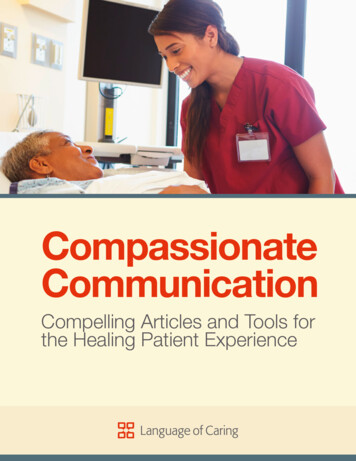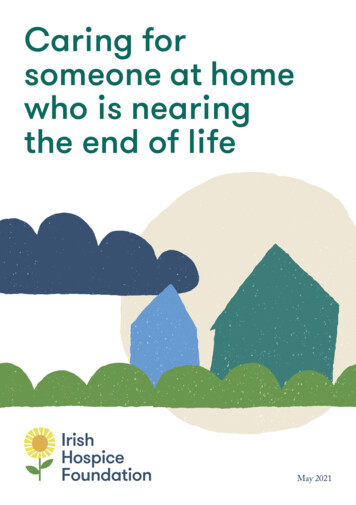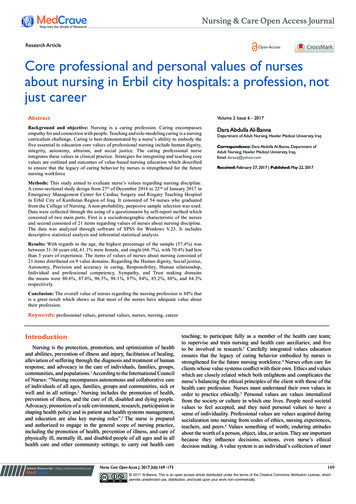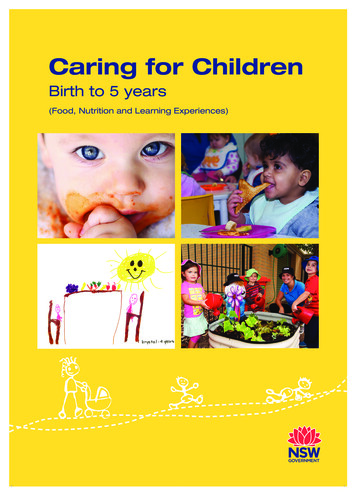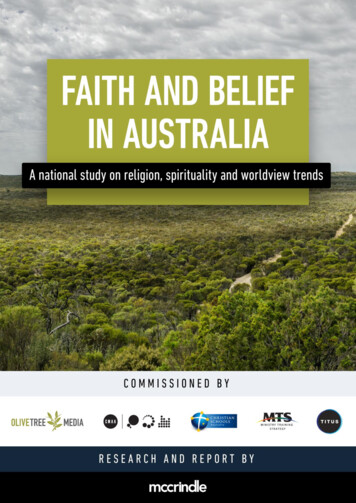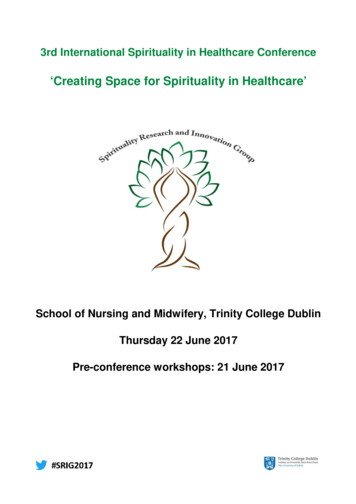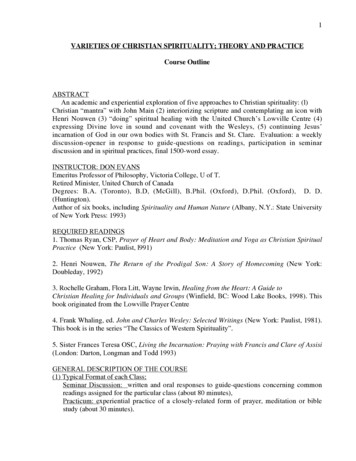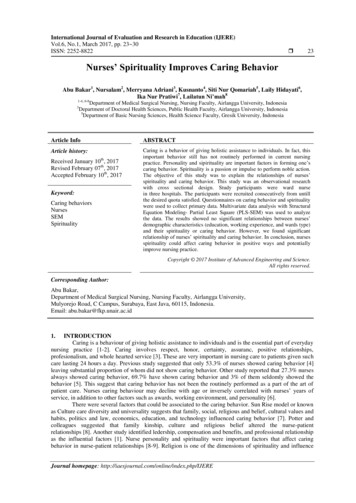
Transcription
International Journal of Evaluation and Research in Education (IJERE)Vol.6, No.1, March 2017, pp. 23 30ISSN: 2252-8822 23Nurses’ Spirituality Improves Caring BehaviorAbu Bakar1, Nursalam2, Merryana Adriani3, Kusnanto4, Siti Nur Qomariah5, Laily Hidayati6,Ika Nur Pratiwi7, Lailatun Ni’mah81-4, 6-8Department of Medical Surgical Nursing, Nursing Faculty, Airlangga University, IndonesiaDepartment of Doctoral Health Sciences, Public Health Faculty, Airlangga University, Indonesia5Department of Basic Nursing Sciences, Health Science Faculty, Gresik University, Indonesia3Article InfoABSTRACTArticle history:Caring is a behavior of giving holistic assistance to individuals. In fact, thisimportant behavior still has not routinely performed in current nursingpractice. Personality and sipirituality are important factors in forming one’scaring behavior. Spirituality is a passion or impulse to perform noble action.The objective of this study was to explain the relationships of nurses’spirituality and caring behavior. This study was an observational researchwith cross sectional design. Study participants were ward nursein three hospitals. The participants were recruited consecutively from untillthe desired quota satisfied. Questionnaires on caring behavior and spiritualitywere used to collect primary data. Multivariate data analysis with StructuralEquation Modeling- Partial Least Square (PLS-SEM) was used to analyzethe data. The results showed no significant relationships between nurses’demographic characteristics (education, working experience, and wards type)and their spirituality or caring behavior. However, we found significantrelationship of nurses’ spirituality and caring behavior. In conclusion, nursesspirituality could affect caring behavior in positive ways and potentiallyimprove nursing practice.Received January 10th, 2017Revised February 07th, 2017Accepted February 10th, 2017Keyword:Caring behaviorsNursesSEMSpiritualityCopyright 2017 Institute of Advanced Engineering and Science.All rights reserved.Corresponding Author:Abu Bakar,Department of Medical Surgical Nursing, Nursing Faculty, Airlangga University,Mulyorejo Road, C Campus, Surabaya, East Java, 60115, Indonesia.Email: abu.bakar@fkp.unair.ac.id1.INTRODUCTIONCaring is a behaviour of giving holistic assistance to individuals and is the essential part of everydaynursing practice [1-2]. Caring involves respect, honor, certainty, assuranc, positive relationships,profesionalism, and whole hearted service [3]. These are very important in nursing care to patients given suchcare lasting 24 hours a day. Previous study suggested that only 53.3% of nurses showed caring behavior [4]leaving substantial proportion of whom did not show caring behavior. Other study reported that 27.3% nursesalways showed caring behavior, 69.7% have shown caring behavior and 3% of them seldomly showed thebehavior [5]. This suggest that caring behavior has not been the routinely performed as a part of the art ofpatient care. Nurses caring behaviour may decline with age or inversely correlated with nurses’ years ofservice, in addition to other factors such as awards, working environment, and personality [6].There were several factors that could be associated to the caring behavior. Sun Rise model or knownas Culture care diversity and universality suggests that family, social, religious and belief, cultural values andhabits, politics and law, economics, education, and technology influenced caring behavior [7]. Potter andcolleagues suggested that family kinship, culture and religious belief altered the nurse-patientrelationships [8]. Another study identified ledership, compensation and benefits, and professional relationshipas the influential factors [1]. Nurse personality and spirituality were important factors that affect caringbehavior in nurse-patient relationships [8-9]. Religion is one of the dimensions of spirituality and influenceJournal homepage: http://iaesjournal.com/online/index.php/IJERE
24 ISSN: 2252-8822spiritual life of the believers [10-11]. Spiritual beliefs are associated with the creator and correlate with thetendency of done noble conduct [11-12]. Nurses’ spirituality that is influenced by religious belief may likelyencourage nurses the perform caring behavior. This study aimed to assess the effect of nurses’ spirituality oncaring behaviour during daily nursing practice.2.RESEARCH METHODThis study used cross sectional design aimed to assess whether the spiritual aspect of nurses couldimprove caring behaviour in positive direction. Figure 1 showed research variables that caring behaviorperformed by nurses must involved spiritual aspect and other factors that related are service factors andpatients factors. Caring behavior of nurses were faced with a need to improve work satisfaction and patientsatisfaction. Caring behavior of nurses measured by aspect of assurance, knowledge and skill, respect, andpositive connectness. This study was conducted in wards unit of hospitals involving nurses that responsible inproviding care to patients. Participated hospitals in this study include Haji Hospital Surabaya, Al IrsyadGeneral Hospital Surabaya and Muhammadiyah General Hospital in Gresik district. Participants wererecruited consecutively until desired number of samples was satisfied. Participants’ Demographics andbaseline data were recorded with standardized form and used throughout the study. Assessment onspirituality and caring behaviour was done using questionnaires.Descriptive data analysis was performed to identify indicators that influence caring, spiritual andtype of nursing care. The analysis was conducted by creating frequency distribution and calculates thefrequency and percentage of the measured variables. A description of each indicator is expressed in the valueof the frequency and average. Data was analyzed by multivariate statistical tests using Structural EquationModeling- Partial Least Square (PLS-SEM) to test hypothesis.Nurse FactorsAge, Education, Sex,Psychological, Communication,Economics,SpiritualService Factors,Politics, Law, and TechnologyClass of WardsCaring behaviorsWork Satisfaction1.2.3.4.AssuranceKnowledge and skillRespectPositive ConnectnessPatient SatisfactionPatient FactorsAge, Prognosis, Economics,Education, PsychologicalRespons, Religion & Trust,Experience hospitalization, andLong of treatmentFigure 1. Research VariablesThis study has been reviewed and approved by the Health Research Ethics Committee of the Facultyof Nursing, University of Airlangga on November 9, 2016, with the approval letter number 243-KEPK.Principles of ethics applied in this study include the principle of self-determination, privacy/confidentiality,anonymity, protection from discomfort, and justice. Written informed consent was provided for allparticipants prior of study commencement and participants were free to withdraw from the study at any stage.IJERE Vol. 6, No. 1, March 2017 : 23 – 30
IJERE ISSN: 2252-8822253.RESULTS AND ANALYSISBetween October and December 2016, there were 88 nurses from three hospitals consented toparticipate with 16 males and 72 females. There was a diverse characteristic of participants as shown inTable 1. Thirteen perecent of nurses have experienced psychosocial problems with varying degrees. Medianworking experience was 7 years ranging from 1 to 27 years. Most of the participating nurses had 3 years ofdiploma certification with only 18% of them had bachelor of nursing certification. More than half of thenurses were recruited from class 3 level of care ward with 59% participants and others were from class I andII with 25% and 16 % respectively. SEM-PLS analysis showed that psychosicial indicators were the onlyvalid variables (loading factors 0.5) in measuring the characteristics with loading factor of 0.954.Table 1. Characteristics of Nurses and PLS Analysis found Results for outer loadingCharacteristicsPsychosocial (D1)Length of work (D2)Education (D3)Wards Unit (D4)CriteriaNot presentSometimesMeanMedianStd. DeviationMinimumMaximumDiplomaBachelorClass 1Class 2Class 3Value87%13%8.53 years7 years6.324 years1 years27 years82%18%25%16%59%Original sample estimate0.9540.2540.066-0.092Table 2 shows spiritual aspects of nurses’ assesed in this study including patience, sincerity, andgratitude behaviour. Most nurses often behave patience (55%), always behave sincerity (72%), and alwaysbehave gratefully (69%) when providing care to patients. Multivariate statistical tests using SEM-PLSmethod yielded relationship between indicators and their construct.The indicator was valid the loading factorwas equal or greater than 0.5. Patience, sincerity and gratitude were statistically significant or valid inmeasuring nurses’ spirituality.Table 2. Spiritual Nurses and PLS Analysis found Results for outer loadingVariableSpiritualityPatience (S1)Sincerity (S2)Gratitude (S3)CriteriaSometime behaveOften behaveAlways behaveSometime behaveOften behaveAlways behaveSometime behaveOften behaveAlways behaveSometime behaveOften behaveAlways ginal sample estimate-0.7960.8150.863Table 3 explains nurses caring behavior and its subscales analysis. Most observed nurses in thisstudy often show caring behaviour (68%), other respondents said that they sometime or always show caringbehaviour with 11% and 20% respondents respectively. Analysis on caring subscales indicate that mostnurses often show guarantees behaviour (60%), respect (57%), positive relationships (59%), but 49% of themalways showed professional behavior. Consistent caring behaviour only showed by less than 50% of nursesin almost all subscales. The subscales used in this analysis was further shown to be a valid indicator of caringbehaviour by SEM-PLS analysis loading factors of more than 0.5 in all aspects.Table 4 is a summary of PLS analysis showing relationships of participants characteristics,spirituality, and caring behaviour. The analysis showed that participants’ spirituality aspect has significantrelationships towards caring behaviour as shown by t-statistics of greater than 1.96. Based on the R-squarevalues in Table 5, it can be explained that: 1. The value of R-square for endogenous variable of caring 0.423.This means that caring behavior could be explained by participants characteristics and spiritual factors by42.3%, other indicators were guarantee behavior, respect, positive relationships, and professionalism. 2.Nurses’ Spirituality Improves Caring Behavior (Abu Bakar)
26 ISSN: 2252-8822Spirituality factors can be explained by the participants’ characteristic at only 17.0%. The remaining factorswere patience, sincerity and gratitude.Table 3. Caring Nurses and PLS Analysis found Results for outer loadingVariableCaringCriteriaSometime behaveOften behaveAlways behaveSometime behaveOften behaveAlways behaveSometime behaveOften behaveAlways behaveSometime behaveOften behaveAlways behaveSometime behaveOften behaveAlways behaveGuarantees (C1)Respect (C2)Positive Relationships (C3)Professional %49%Original sample estimate-0.8520.8950.9270.870Table 4. The results of PLS analysis found Results for inner weightsVariableCharacteristic CaringCharacteristic SpiritualSpiritual CaringT- Statistic0.3441.0057.061Table 5. The value of R-Square on the path diagramVariable endogenCaringSpiritualR- Square0.4230.170Figure 2 conclude from Table 1 to 4 about nurses’ caring behavior model. SEM PLS models onrelationships of nurses’ characteristic, spirituality and caring behaviour. Nurses’ caring behavior modelshowed result of relationships between indicator and their construct whether it significant or not.Figure 2. Spirituality and Caring relationships model3.1 Analyzing Relationships of Demographic Characteristics with the Spirituality of NursesOur study found that nurse’s background characteristics was not significantly associated with theirspirituality. This was consistent with previous study exploring nurses’ baseline characteristics includingeducation, job position and working experience with spiritual intelligence [13]. The study suggested thatnurses psychosocial aspects, emotional side and positions when dealing with environment, was the onlyIJERE Vol. 6, No. 1, March 2017 : 23 – 30
IJEREISSN: 2252-8822 27factors significantly depicts nurses’chracteristics. This situation shows that psychosocial as spiritualexperience was fiscal in nature and emotional, and was common in critical situation. The theory behind thiswasthat person's spiritualitycould be influenced by stage of development, family role, culture, lifeexperiences, and the critical condition [11].This study also found that nurses’ charracteristics could be the factors associated with theirspirituality, other factors include patience, sincerity and gratitude behavior. Patience, sincerity and gratitudebehavior were the thought process of the nurse to perform spiritual behavior [10]. Spiritual often influencedby the thought process [14-15]. This indicates that spiritual aspects can be evaluated from all factorsassociated with thought process, but not physical factors.3.2 Analyzing the Relationship between Demographic with Caring BehaviorThis study found that nurses’ baseline characteristics have no significant relationships to caringbehavior. Similar results were also confirmed by previous study in Jakarta, Indonesia [6]. However, recentstudies suggested that there was a significant relationship between nurses’ characteristics and caringbehavior [16-17]. The odds maybe due to homogeneity in psychosocial aspects, working experience,educational backgrounds, and wards unit of participants in this study. Previous report suggested that caringbehavior was inversely associated with working experience [6], but ours indicated that working experiencehas no effect on caring behavior as shown by the distribution of caring behaviors that were spread throughoutthe participants. This showed that the nurses who participated in this study had a good caring at level ofworking experience.The education level of nurses in this study was dominated by nurse with diploma certification. Therewas no significant relationship of educational background with caring bahavior, as also confirmed by theprevious study [6]. This result reveals that caring behavior was not determined by the level of education. Interm of caring behavior relation to ward level of care, our study observed high percentage of caring behaviorin class III level of care, although was different with the previous similar study [6]. However, overall resultssuggested nurses expressed caring bahavior in all class level of care.3.3 Analyzing the Spiritual Relationship of Nurses with Caring NursesOur findings showed that nurses’ spirituality has significant relationships with their caring behavior.This was consistent with Priambodo and colleagues study suggesting strong relationships of caring andspirituality [9], also supported by Watson’s theory on nurse sipituality and caring [18]. Sun rise theoriticalmodels also support this findings [7]. There seems to be harmony between spirituality and caring behavior,and such behavior was positively correlated with spirituality.Spirituality refered in this study were patience, sincere and gratitude, and these have been shown tobe significant indicators to measure nurse spirituality. Sincerity was included in the spirituality assesment asit reflects surrender to God, enjoying process of life (patient), and ability to feel grateful [19]. These resultsindicate that a person's spirituality, either nurse or patient can be observed from their patience, sincerity, andgratitudeness.Caring behavior in this study includes guarantee behavior, respect, positive relationships andprofessionalism. These factors has been shown to be significant in measuring caring behavior. The resultswere also consistent with previous study by Killic et al using the indicators [20]. However, the behaviorswere not routinely performed by nurses in daily practice, yet they often behave. Caring behavior could beexlained moderately by nurses’ characteristics spirituality at about 42.3 %, and was supported by previousstudy showing caring behavior was heavily influenced by nurse themselves [17]. Caring behavior should beexpressed by nurses in their daily practice, with providing guarantee of service, respect patients’ rights,maintaining positive relationships and professionalism.4.CONCLUSIONNurses’ spirituality has significant relationships with their caring behavior. We suggest that nursesneed to maintain their spirituality (gratitudeness, sincerity, and patience) to provide excellent care. Maintainnurses’ spirituality by give spiritual training to nurses regularly. The following recommendations for furtherresearch are: use observational instruments to measure spiritual nurses and caring behavior to get anobjectivity, next research method use an experimental study with the intervention of Islamic Caring.Nurses’ Spirituality Improves Caring Behavior (Abu Bakar)
28 ISSN: 2252-8822ACKNOWLEDGEMENTSI would like to acknowledge all of respondents and nursing department of Haji Hospital Surabaya,Al-Irsyad Hospital Surabaya and Muhammadiyah Hospital in Gresik for their cooperation and support, thusmade this study [11][12][13][14][15][16][17][18][19][20]Tonges, Mary & Ray, Joel. “Translating Caring Theory Into Practice: The Carolina Care Model”. The Journal OfNursing Administration. Vol 4 No 9, pp. 374- 381, 2011.Nursalam. “Caring as Basic to Increase Quality of Nursing Services and Patient Safety”. Surabaya: AirlanggaUniversity press, 2014.Rafii, Forough; hajinezhad, Mohammad Esmalel; & Haghani, Hamid. ”Nurse caring in Iran and its relationshipwith patient satisfaction”. Australian Journal of Advanced Nursing, Vol 26, No 2, pp. 75-84, 2007.Nensi, S.C. & Rosaline, M.H. “Relationship Nurses’ Caring Behavior with Client Satisfaction Level in WardsSiloam Hospital Lippo Karawaci”. Research Report, FIK. UI, 2008.Putra, Panji Pratama. “Relationship Nurses’ Caring Behavior with Patient Satisfaction in Third Class MarwahWards PKU Muhammadiyah Yogyakarta Hospital”. Published by Nursing Science Program Study, Health ScienceInstitute Aisyiyah Yogyakarta. kasi.pdf, 2011.Respati, Rurry Diane. “Descriptive Study Nurses’ Caring Behavior based on Wards Unit. Research Paper. UniversityDepok.http://lontar.ui.ac.id/file?file digital/20311948-S43431-Studi%20diskriptif.pdf, 2012.Tomey, A. M., & Alligood, M. R. “Nursing Theorists and their work” (8th ed.). Philadelphia: ELSEVIER, pp. 318325, 2014.Potter, P. A., & Perry, A. G. “Fundamentals of Nursing: Concepts, Process and Practice (7th ed.). translated by:Adriana Ferderika Nggie & Marina Albar. Jakarta: Salemba Medika, 2010.Priambodo, Galih. “Caring in Nursing Practice: Caring Category based on Culture”. Thesis. Magister publik/t34187.pdf, 2014.Syarif, F. “The Power of Spirituality: Reach Success without Limit”. Jakarta: Emir, pp 63- 93, 2015.Hamid, A.Y. “Text Book Spirituality Aspect in Nursing”. Jakarta: Widya Medika, 2008.El-Ma’rufie, Sabil. “Inspiring Dhuha Pray: Open Prosperity Gate”. Bandung: Mizania, 2010.Yang, Ke-Ping & Mao, Xiu-Ying. “A study of nurses’ spiritual intelligence: A cross-sectional questionnairesurvey”. International Journal of Nursing Studies. Issue 44. pp 999–1010. 2007.Zohar, D., & Marshall, I. “SQ: Spirituality Intelligence”. (10th ed). translated by: R. Astuti, A. N. Burhani, & A.Baiquni. PT Mizan Pustaka. Bandung, pp3- 14, 2007.Mark, G and Lyons, A “Conceptualizing mind, body spirit interconnections through, and beyond, spiritual healingpractice”. Explore. Elsevier. Vol 10, No 05. pp 294-299. 2014.Youssef H.A.M., Mansour M.A.M., Ayasreh I.R.A., and Al-Mawajdeh N.A.A."A Medical-Surgical Nurse'sPerceptions of Caring Behaviors among Hospitals in Taif City". Life Science Journal. vol.10 No.04. pp 720-730.2013.Hajinezhad, Mohammad Esmaiel & Azodi, Parviz. “Nurse Caring Behaviors from Patients’ and Nurses’Perspective: A Comparative Study”. European Online Journal of Natural and Social Sciences. Vol.3, No.4 pp.1010-1017, 2014.Watson, J. “Nursing: The philosophy and science of caring”. Revised edition. Association of American UniversityPress. Colorado, pp. 214-219, 2008.Sentanu, Erbe. “Sincerity Quantum: New Edition”. Jakarta. PT Elex Media Komputindo, 2014.Kilic, Meryem & Oztunq, Gursel. “Comparison of nursing care perceptions between patients who had surgicaloperation and nurses who provided care to those patients”. International journal of caring sciences. Volume 8 No 3page 625- 632, g/docs/13 Kilic original 8 3.pdf., 2015.BIBLIOGRAPHY OF AUTHORSName: Abu BakarEmail: abu.bakar@fkp.unair.ac.idTelp. : 628121678013Education : Doctoral Student of Public Health Faculty, Airlangga University (2014-present)Magister Nursing of Nursing Scince Faculty, Indonesia University (2007-2009), Bachelor ofNursing of Nursing Faculty, Airlangga University (2003-2006)Experience: Lecturer of Medical Surgical Nursing Department, Nursing Faculty, AirlanggaUniversity (2006-present), Association Cardiology Nurse Practitioner, Medical SurgicalSpecialists (2009-present)Awards: Research Awards RKAT FKP UNAIR years: 2010, 2011, 2012, 2013, 2014, 2016,Research Award PUPT RISTEKDIKTI year: 2014IJERE Vol. 6, No. 1, March 2017 : 23 – 30
IJEREISSN: 2252-8822 29Name: NursalamEmail: nursalam@fkp.unair.ac.idEducation : Profesor in Nursing (2014), Doctoral of Medicine Faculty, Airlangga University(2005), Magister Nursing of University Of Wollongong (1998), Bachelor of University OfWollongong (1995)Experience: Lecturer of Medical Surgical Nursing Department, Nursing Faculty, AirlanggaUniversity (1995-present)Awards: Research Award PUPT RISTEKDIKTI year: 2014; 2015; 2016Name: Merryana AdrianiEmail: merryana a@fkm.unair.ac.idEducation : Doctoral Public Health of Public Health Faculty, Airlangga University (2009),Magister Nutrition Health of Public Health Faculty, Airlangga University (2000), Bachelor ofPublic Health Faculty, Airlangga University (1988)Experience: Lecturer of Nutrition Health Department, Public Health Faculty, AirlanggaUniversity (1995-present)Awards: Research Award PUPT RISTEKDIKTI year: 2014; 2015; 2016Name: KusnantoEmail: kusnanto@fkp.unair.ac.idEducation : Doctoral of Medicine Faculty, Airlangga University (2012), Magister Medicine ofMedicine Faculty, Airlangga University (2003), Bachelor of Nursing of Nursing Faculty,Padjadjaran University (1989)Experience: Lecturer of Medical Surgical Nursing Department, Nursing Faculty, AirlanggaUniversity (1995-present)Awards: Research Award PUPT RISTEKDIKTI year: 2014, 2015, 2016Name: Siti Nur QomariahEmail: snurq18@gmail.comEducation : Magister Nursing of Nursing Faculty, Airlangga University (2014), Bachelor ofNursing of Nursing Faculty, Airlangga University (2008)Experience: Lecturer of Departement of Basic Nursing Sciences, Health Science Faculty, GresikUniversity (2011- present)Awards: Research Award PDP RISTEKDIKTI year: 2016Name: Laily HidayatiEmail: laily-h@fkp.unair.ac.idEducation : Magister Nursing of Nursing Scince Faculty, Airlangga University (2012), Bachelorof Nursing of Nursing Faculty, Airlangga University (2007)Experience: Lecturer of Medical Surgical Nursing Department, Nursing Faculty, AirlanggaUniversity (2013-present)Awards: Research Awards RKAT FKP UNAIR years: 2014, 2015, 2016Name: Ika Nur PratiwiEmail: ikanurpratiwi@fkp.unair.ac.idEducation : Magister Nursing of Medicine Faculty, Gadjah Mada University (2014), Bachelor ofNursing of Medicine Faculty, Brawijaya University (2011)Experience: Lecturer of Medical Surgical Nursing Department, Nursing Faculty, AirlanggaUniversity (2015-present)Awards: Research Awards RKAT FKP UNAIR years: 2014, 2015, 2016Nurses’ Spirituality Improves Caring Behavior (Abu Bakar)
30 ISSN: 2252-8822Name: Lailatun Ni’mahEmail: lailatunnimah@fkp.unair.ac.idEducation : Magister Nursing of Nursing Scince Faculty, Airlangga University (2014), Bachelorof Nursing of Nursing Faculty, Airlangga University (2009)Experience: Lecturer of Medical Surgical Nursing Department, Nursing Faculty, AirlanggaUniversity (2015-present)Awards: Research Awards RKAT FKP UNAIR years: 2014, 2015, 2016IJERE Vol. 6, No. 1, March 2017 : 23 – 30
Depart ment of Medical Surgical Nursing, Nursing F aculty, Airlangga University , Mulyorejo Road, C Campus, Surabaya, East Java, 60115, Indonesia . Email: abu.bakar@fkp.unair.ac.id 1. INTRODUCTION Caring is a behaviour of giving holistic assistance to individuals and is the essential part of everyday nursing practice [1-2].
